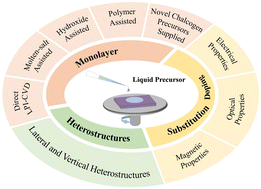Liquid-precursor-intermediated synthesis of atomically thin transition metal dichalcogenides
Abstract
With the rapid development of integrated electronics and optoelectronics, methods for the scalable industrial-scale growth of two-dimensional (2D) transition metal dichalcogenide (TMD) materials have become a hot research topic. However, the control of gas distribution of solid precursors in common chemical vapor deposition (CVD) is still a challenge, resulting in the growth of 2D TMDs strongly influenced by the location of the substrate from the precursor powder. In contrast, liquid-precursor-intermediated growth not only avoids the use of solid powders but also enables the uniform distribution of precursors on the substrate through spin-coating, which is much more favorable for the synthesis of wafer-scale TMDs. Moreover, the spin-coating process based on liquid precursors can control the thickness of the spin-coated films by regulating the solution concentration and spin-coating speed. Herein, this review focuses on the recent progress in the synthesis of 2D TMDs based on liquid-precursor-intermediated CVD (LPI-CVD) growth. Firstly, the different assisted treatments based on LPI-CVD strategies for monolayer 2D TMDs are introduced. Then, the progress in the regulation of the different physical properties of monolayer 2D TMDs by substitution of the transition metal and their corresponding heterostructures based on LPI-CVD growth are summarized. Finally, the challenges and perspectives of 2D TMDs based on the LPI-CVD method are discussed.

- This article is part of the themed collections: Recent Review Articles and New horizons in materials for energy conversion, optics and electronics


 Please wait while we load your content...
Please wait while we load your content...